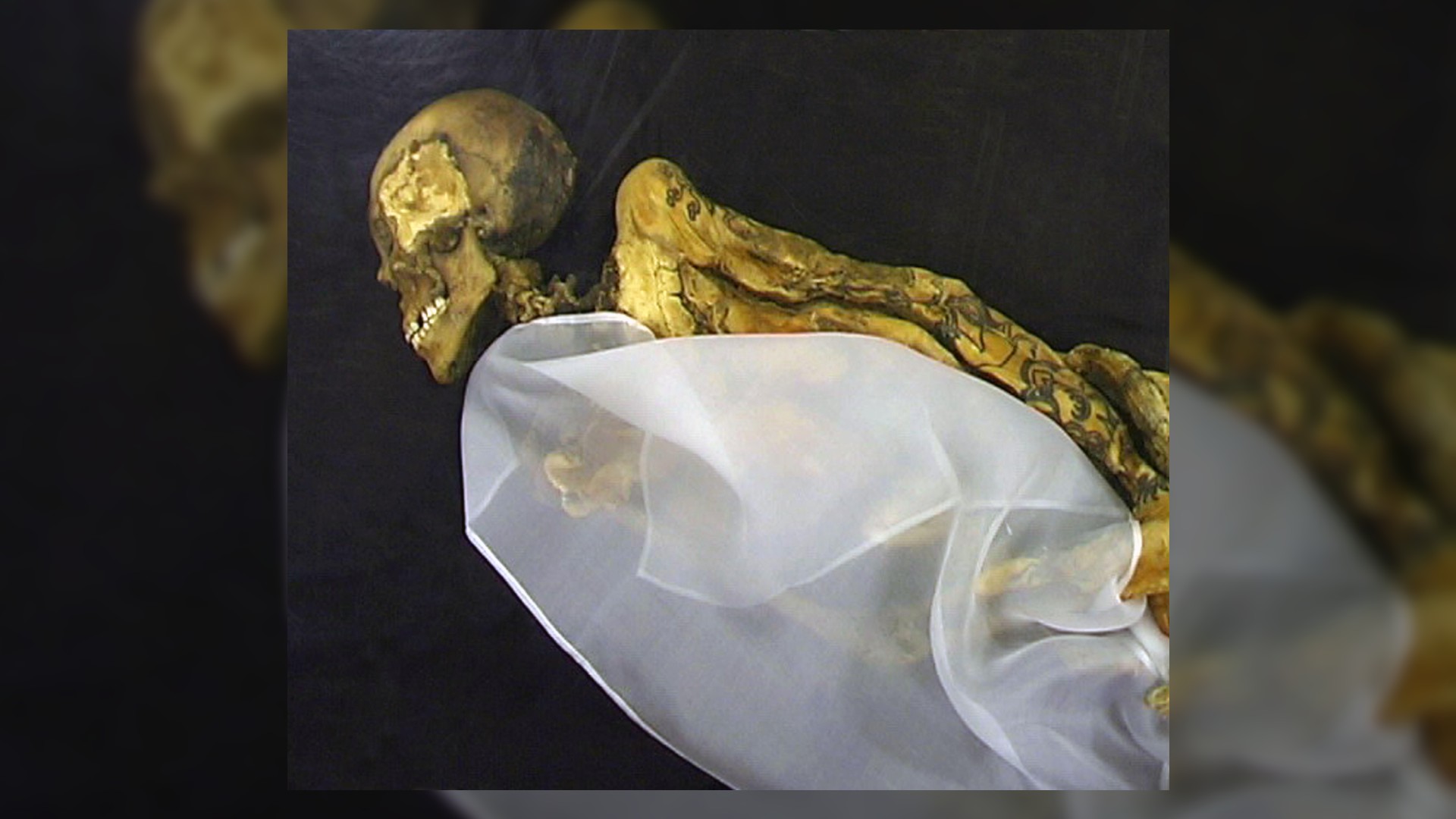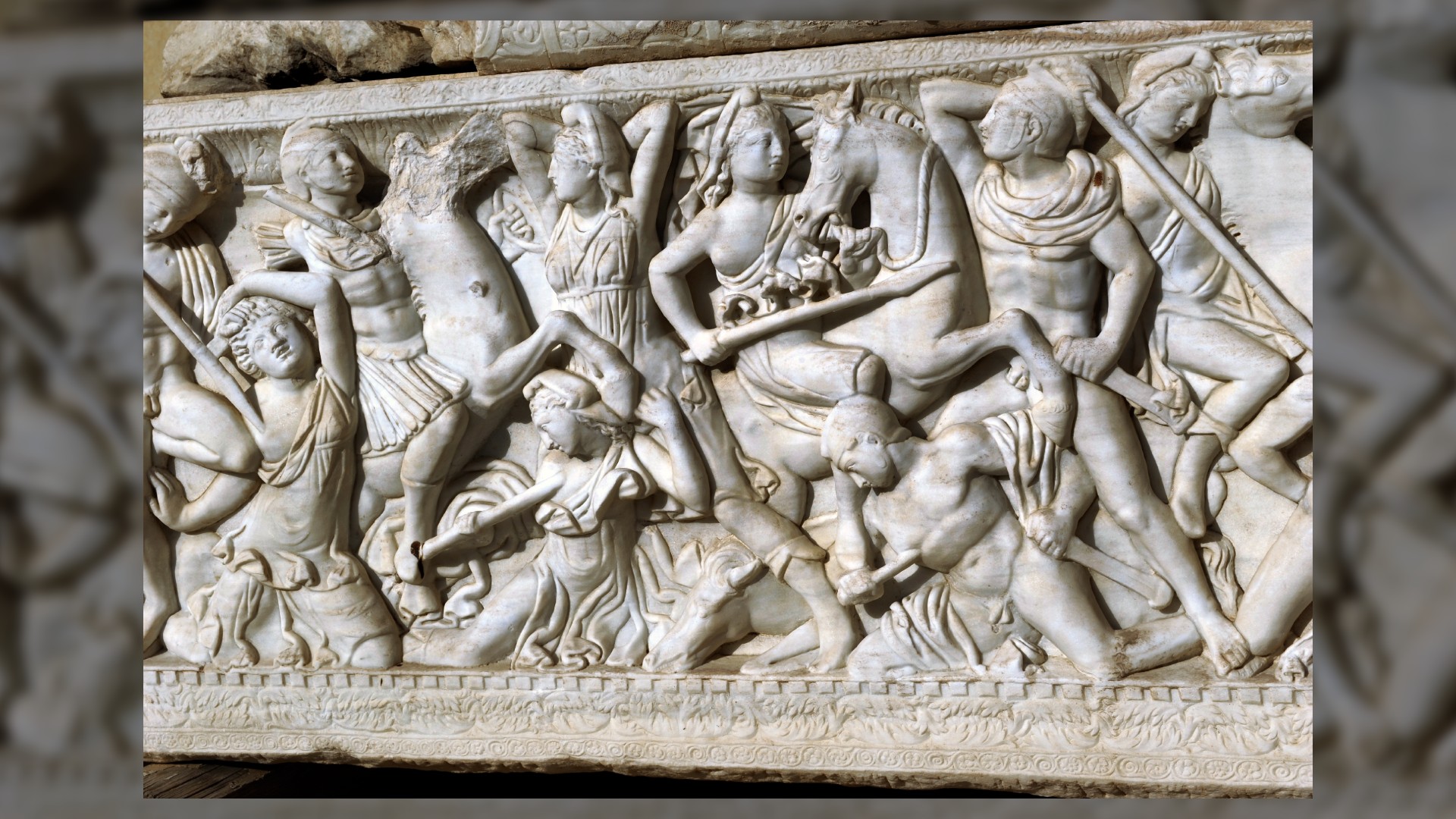Who were the Scythians?
The Scythians were nomadic pastoralists and formidable warriors.
"Scythian" is a term used to denote a diverse but culturally related group of nomads who occupied a large swathe of grassland, or steppes, that stretched from north of the Black Sea all the way to China. Sometimes also known as Saka or Scyths, the name "Scythian" was coined by the ancient Greeks.
"Scythian culture flourished on the steppes from about 800 B.C. to about A.D. 300," Adrienne Mayor, a folklorist and historian at Stanford University and the author of "The Amazons: Lives and Legends of Warrior Women across the Ancient World" (Princeton University Press, 2014), told Live Science.
The Scythians were known to many ancient civilizations, she said, including the ancient Greeks, Persians, Romans and Chinese, and they perfected the art of archery on horseback — even without the use of stirrups or saddles. They had a reputation for ferocity in battle and were masters of hit-and-run battle tactics.
The origins of the Scythians and their empire
There is much debate about the origins of the Scythians. According to the fifth-century B.C. Greek historian Herodotus, the Scythians originally inhabited Asia but were pushed west by a hostile tribe. They eventually reached the Black Sea region and the eastern outskirts of Europe, where they, in turn, pushed out the existing inhabitants. By contrast, the Greek writer Diodorus Siculus, writing in the first century B.C., claimed that the Scythians moved north into the steppe region from the south, possibly from the modern area of Armenia or even farther south along the western border with India.
In a different and far more fanciful origin story, Herodotus tells how the Scythians were the descendants of the mighty hero Heracles and a creature who was half woman and half snake. In this story, Heracles encountered the creature while traveling in the lands east of Greece. After stealing Heracles' horses, the creature demanded that if he wanted them back, he would have to stay and mate with her. The union produced three sons, one of whom was named Scythes, who became the ancestor of the Scythian nobility.
Modern historians, however, have used archaeological and genetic evidence to reconstruct the Scythians' origins.
"It appears that what we call Scythian culture emerged more than 2,500 years ago, as a combination of Siberian, East Asian, and Yamnaya Eurasian groups," Mayor told Live Science. "Just as the region of ancient Scythia had many different languages, great ethnic diversity is also found in Scythian ancestry, especially in the maternal line. All the studies so far confirm that Scythians were not a single homogeneous group."
Get the world’s most fascinating discoveries delivered straight to your inbox.
Although genetic studies are revealing a great deal about the makeup of the diverse peoples of the lands once known as Scythia, the full story is not yet known and still debated, Mayor noted.
Social organization and burials
The open grassland of the steppes — an environment of vast plains and low, rolling hills — was beneficial to pastoralism, and for millennia human populations in this landscape tended large herds of livestock. The Scythians were no exception. They tended herds of cattle and horses, according to Herodotus, and most people roamed the steppes rather than settling down in permanent habitations. According to World History Encyclopedia, the Scythians moved about the landscape in wagons driven by oxen. Some of these wagons were large and elaborate, with multiple rooms. When multiple wagons traveled together, the conglomeration resembled a city or large settlement.
The Scythians were organized into tribes that were not united politically but shared a common language, culture, style of dress and art style. During certain periods, such as times of war or the celebration of ritual undertakings, different tribes came together to form larger political units or confederations. It is unclear whether Scythian society had sharp social divisions, such as hereditary elites, but in many respects they appear to have been relatively egalitarian, Mayor said — especially with regard to gender roles.
The historical and archaeological record indicates that Scythian women enjoyed considerable autonomy and privilege that would not be rivaled until modern times, according to World History Encyclopedia. For example, many Scythian women served alongside men as mounted horse archers (more on this below) and could hold leadership roles in Scythian society. Moreover, numerous Scythian burials show that women were often interred with as much elaborate offerings as men. In 2019, for instance, a burial containing four women was found that contained offerings typically reserved for men, including weapons and gold, the Smithsonian Magazine reported.
Herodotus mentioned the existence of Scythian "kings," using the term "Royal Scythians" to designate this group. He indicated that they were a separate tribe and lived in what is now the southern part of Ukraine, immediately north of the ancient Greek towns that clustered around the Black Sea. Herodotus indicated that they wielded considerable political and military power, and that they were a hereditary elite, but it is unclear what their relation was to the other Scythian tribes.
When a Royal Scythian died, a large grave consisting of a "great four-cornered pit in the ground" was prepared, and the individual's body was placed inside, according to Herodotus. The individual was buried with his "concubines, his cupbearer, his cook, his groom, his squire, and his messenger, besides horses, and first-fruits of all else, and golden cups," Herodotus wrote (translated from ancient Greek.) The king's retainers then covered the grave with dirt and erected a mound, vying "zealously with one another to make this as great as may be."
Archaeologists have excavated some of these high-status tombs, which are called kurgans. One of these, found in southern Siberia, dates from 2,800 years ago and was wider than the length of a football field, Live Science previously reported. It contained the burial of a man and woman and was filled with gold jewelry, weapons, richly decorated cups (some with traces of drugs like opium) and other grave goods.
Scythian clothes, tattoos and artwork
Several classical writers mention the Scythians' distinctive dress, describing the men as wearing peaked caps, colorful tunics and, most characteristically, long trousers that reached down to the ankles. The Scythians were fond of elaborate designs, intricate embroidery and bold colors. Men and women wore boots that were, like the Scythian attire in general, colorful and emblazoned with many designs and patterns. One of these, a woman's boot, was found in the Altai Mountains in central Asia and dates to around 2,300 years ago, ZME Science reported.
The Scythians were famous for their practice of tattooing. Designs of real and mythical animals, many rendered in highly stylized patterns, were especially prominent on arms and legs. According to The Siberian Times, the mummy of a young woman, dubbed the Ukok Princess, was found in 1993; she displayed a series of elaborate tattoos, including depictions of a deer, a panther and a griffon. Other tattooed mummies have been found throughout the ancient Scythian region.
Many ancient accounts mention the Scythians' love of gold artwork and jewelry. Numerous pieces of Scythian art — including pendants, clasps, brooches, necklaces, combs and choker-like necklaces known as gorgets — have been found in kurgans. Like Scythian tattooing, these pieces are distinctive for their intricate designs and stylized ornamentation. There is evidence that Greek merchants may have been responsible for creating some of these gold pieces and that a lively trade existed between the Greeks and Scythians, according to Realm of History, with several pieces imported from the Greek mainland. Like Scythian tattoos, these works of art often depict animals.
Scythian religion
According to World History Encyclopedia, the Scythian religion was an amalgam between Greek religion, which the Scythians may have adopted as a result of contact with far-flung Greek colonists, and older shamanistic elements, such as animal worship. Scholars are still largely in the dark about the specifics of Scythian religion, though the little that is known comes primarily from Herodotus. He claimed that the Scythians, like many ancient peoples, were polytheistic — that is, they worshipped a plethora of deities. Herodotus mentioned eight gods as constituting the Scythian pantheon, all of whom had Greek counterparts. This included the two main gods, Tabitha, who was a goddess of fire and the hearth and most closely associated with the Greek deity Hestia, and Papaeus, the god of the sky who resembled the Greek god Zeus. The other Scythian deities included Goetosyrus (Apollo), Argimpasa (Aphrodite), Api (Mother-Earth), and three additional gods whom Herodotus does not name but associated, respectively, with Ares, Hercules and Poseidon.
One of the most revered deities in the Scythian pantheon was Ares, the Greek god of war. "It is their practice to make images and altars and shrines for Ares, but for no other god," Herodotus wrote. The Scythians frequently sacrificed animals to the gods, such as sheep, goats and cattle, typically using a garrote (iron collar or cord) to strangle the beasts. To Ares, however, Scythians sacrificed both animals and humans. In Book IV, Herodotus described how prisoners of war were occasionally sacrificed to Ares; this occurred at a shrine that had a built-in sword, the symbol of Ares. During human sacrifices, prisoners were reportedly killed with this weapon. "They pour wine on the men's heads and cut their throats over a vessel; then they carry the blood up onto the pile of sticks and pour it on the [sword]," Herodotus wrote.
The older elements of Scythian religion are demonstrated through the propitiation of animals and shamanism. Herodotus described a class of shamans among the Scythians, using the term "diviners." He described them as hereditary and having the power to tell the future — a gift given to them by their Aphrodite-like goddess, Argimpasa. However, if a prediction didn't come to fruition, the diviner could be put to death, usually by burning. These diviners also had the ability to effect cures using herbs and various medicinal plants.
Scythian warriors and weapons
Herodotus wrote of the Scythians' military prowess, describing this aspect of their lives in great detail and categorizing them as "invincible and unassailable." Scythian warriors could achieve high status through skill in battle. "[A Scythian warrior] carried to his king the heads of all whom he has slain in battle, for he receives his share of the booty if he brings a head, but not otherwise," Herodotus wrote (translated from ancient Greek).
The Scythians were especially renowned for their skill as mounted archers.
"Scythian male and female mounted archers were admired and feared by Greeks, Romans, Persians, and the Chinese, whose Great Wall was built to defend against them," Mayor said.
The Scythians' primary weapon was the composite bow, which was made of wood, horn and sinew. It was a remarkably durable and accurate weapon. Scythian warriors also carried an array of other weapons, such as axes, swords, spears and maces. Their military skill was recognized by the many civilizations around them, and Scythian warriors frequently served as mercenaries in foreign armies, such as with the Persian empire and the forces of the Greco-Persian king Mithridates VI.
Scythian women and the myth of the Amazons
The Scythians have often been associated with the legend of the Amazons — fierce women warriors who figure prominently in ancient Greek mythology. Diodorus Siculus was one of the ancient writers who asserted the prominent martial role of Scythian women. "For among these peoples the women train for war just as do the men and in acts of manly valor are in no wise inferior to the men. Consequently, distinguished women have been the authors of many great deeds," he wrote (translated from ancient Greek).
Mayor has explored the connection between the myth and reality of these stalwart women warriors.
"Greek writers such as Herodotus, Plato, Strabo and Pausanias all linked the Amazons of myth to the real, flesh-and-blood women among the warlike Scythian nomads of the steppes," she said. "Now, thanks to recent and spectacular archaeological discoveries of more than 300 ancient women, some with combat injuries, buried with their weapons and horses across ancient Scythia, we know that Greek literature and art about Amazons were strongly influenced by the lives of steppe nomad mounted archers."
The twilight of the Scythian world
Herodotus described a great war between the Scythians and the Persians, under Darius I of the Achaemenid dynasty. It began in 513 B.C. when Darius invaded Scythian lands, intent on subjugating the people living there and bringing them under the Persian yoke. But the campaign proved disastrous; harried by Scythian cavalry, tired by long marches and the unrelenting vastness of the lands they were trying to conquer, the Persian army ultimately turned back. This defeat enabled the Scythians to expand their influence by moving westward into northern Greece and Thrace.
But the Scythians were not so lucky several centuries later. Their power ebbed as they suffered a series of military defeats, first at the hands of Philip II of Macedon (the father of Alexander the Great) in 339 B.C. and then by the Sarmatians, a people culturally and linguistically related to the Scythians, in a prolonged conflict that lasted from the fourth century B.C. to the second century A.D., according to Britannica. They also suffered a major military defeat during the second century B.C., when Mithridates VI, the king of Pontus, in northern Anatolia, decisively defeated Scythian forces and incorporated Scythian warriors into his own army.
A severe blow to Scythian society and political hegemony came during the fourth century A.D., when the Scythians were devastated by the Huns, mounted nomadic warriors from Eurasia who, under their ruler Attila, invaded Europe in the fifth century A.D. According to World History Encyclopedia, the Scythians may have been assimilated by the Goths at this time. Some scholars believe that the Ossetians, who occupy parts of southern Russia and the Caucasus Mountain region, may derive their ancestry from the Scythians.
Mayor, however, cautioned that tales of a culture's ultimate demise can be misleading.
"Although the ancient Scythian culture as the ancient Greeks, Romans and Persians knew them faded with upheavals in the Middle Ages, extinction or integration with other tribes, and the rise of Islam — and despite the modern history of continual conquests, displacements, oppression, and other turbulent events — Scythian traditions never really disappeared," she said. "Scythian customs and expertise in mounted archery continued with the Parthians, the Mongols, and others, and Scythian riding and archery skills and egalitarian values persist in some nomadic and semi-nomadic groups living in Central Asia today."
Additional resources
- Watch a video about the Scythians by historian Barry Cunliffe, author of "The Scythians: Nomad Warriors of the Steppe."
- Read Discover Magazine's article about the warrior women of ancient Scythia.
- Learn about the ancient Scythians at the British Museum.
Originally published on Feb. 10, 2022. Updated on March 18, 2022.
Bibliography
University of Chicago, "Diodorus Siculus, Library of History, Book II:35-60." https://penelope.uchicago.edu/Thayer/e/roman/texts/diodorus_siculus/2b*.html
One Earth, "Pontic Steppe." https://www.oneearth.org/ecoregions/pontic-steppe/
World History Encyclopedia, "Scythians." https://www.worldhistory.org/Scythians/
University of Chicago, "Herodotus, Chapter 4:46-82." https://penelope.uchicago.edu/Thayer/E/Roman/Texts/Herodotus/4C*.html
ZME Science, "Pristine 2,300-year-old Scythian woman's boot found in frozen Altai Mountains." https://www.zmescience.com/science/scythian-boots-0532/
The Siberian Times, "Siberian Princess Reveals her 2,500 year old tattoos." https://siberiantimes.com/culture/others/features/siberian-princess-reveals-her-2500-year-old-tattoos/
Realm of History, "Workmanship beyond warfare: The Scythian 'paradox' in gold-made artifacts." https://www.realmofhistory.com/2015/09/07/workmanship-beyond-warfare-the-scythian-paradox-in-gold-made-artifacts/
World History Encyclopedia, "Scythian Religion." https://www.worldhistory.org/Scythian_Religion/
History Hit, "Why was the Scythian bow so effective?" https://www.historyhit.com/why-was-the-scythian-bow-so-effective/
World History Encyclopedia, "Darius I." https://www.worldhistory.org/Darius_I/
Britannica, "Scythian: Ancient People." https://www.britannica.com/topic/Scythian
World History Encyclopedia, "Mithridates VI." https://www.worldhistory.org/Mithridates_VI/
Britannica, "North Ossetia-Alania." https://www.britannica.com/place/North-Ossetia-Alania#ref95738
Tom Garlinghouse is a journalist specializing in general science stories. He has a Ph.D. in archaeology from the University of California, Davis, and was a practicing archaeologist prior to receiving his MA in science journalism from the University of California, Santa Cruz. His work has appeared in an eclectic array of print and online publications, including the Monterey Herald, the San Jose Mercury News, History Today, Sapiens.org, Science.com, Current World Archaeology and many others. He is also a novelist whose first novel Mind Fields, was recently published by Open-Books.com.







